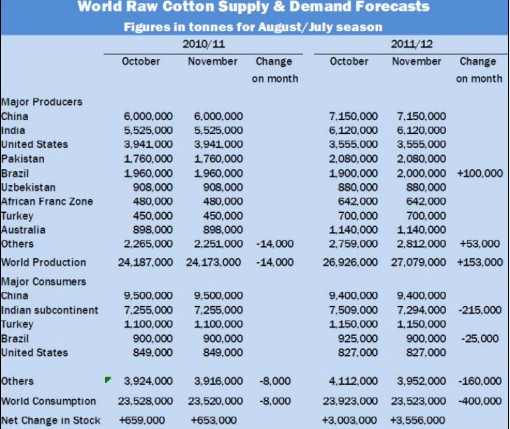|
Domestic garment manufacturers have opposed exports of 5.5 million bales (170 kg each) raw cotton pointing to possible cotton deficit, under-utilisation of yarn and textile mills capacities apart from hike in costs for entire textiles industry. "Cotton exports beyond 5.5 million bales should not be allowed at any cost, since domestic industry consumption as per projections of Cotton Advisory Board is going to be more than 26.6 million bales," said Ashish Bagrodia, chairman of North Indian Textile Mills Association. Bagrodia said the export scheme proposes a carryover of only 5.5 million bales and stock-to-use ratio of only 20 per cent for yarn mills, which is far below world average of about 40 per cent. Yarn mills will remain strained under dual pressure of raw material shortage till March 2011, and high raw cotton prices due to exports till cotton arrivals improve between January and March 2011. "Any exports more than 5.5 million bales must be with export duty keeping in mind cotton security of the country," said Bagrodia, who is also the managing director of BSE-listed Ginni Filaments with a market capitalisation of Rs 109 crore as on October 18. Currently, cotton prices in domestic markets are ruling at around Rs 41,000 per candy (37.32 kilos), about 90 per cent higher than Rs 22,400 per candy in the same period last year. Criticising the government decision to allow exports of 5.5 million bales, Confederation of Indian Textile Industries (Citi), premier textile industry body, has also petitioned prime minister Manmohan Singh on the issue pointing to possible cotton deficit in the country. Citi chairman Shishir Jaipuria said that exporters are to ship out 5.5 million bales by December 15, and would thus look to finish procurement latest by next month end. Arrival of lint cotton in the market up to November 30 would be only around 60-65 lakh bales and consumption during the period would exceed 45 lakh bales. Thus, even if last year's ending stock of 40.5 lakh bales as estimated by Cotton Advisory Board is taken into account in full, there will be practically no cotton stock left in the country if 55 lakh bales get exported during this time. This will lead to a cotton famine in the country and mills will be forced to close down or scale down production drastically, Jaipuria said in his SOS to Prime Minister. Speaking to Financial Chronicle, Jaipuria said yarn manufacturers are already short of raw materials and the cotton crisis has begun. In October itself arrivals are expected at 500,000 to 700,000 bales against consumption of 2.7 million bales, he said. To ease the crisis, Citi had sought delaying cotton exports till January 2011 and phased exports of one million bales per month there after. With the situation likely to result in a shortage of yarn, apparel manufacturers too have raised concerns over raw cotton exports. Our cotton traders receive export incentives. Extending this price advantage to China and Bangladesh is bleeding us of raw materials for the domestic apparel and yarn industry and will result in price spiral for textile products, adding to inflationary pressures, said Director (economic and consultancy) at Apparel Export Promotion Council, Chandrima Chatterjee. The AEPC has been seeking government intervention to boost exports of garments and value added products in the lines of China and Bangladesh. Textile ministry on its part seems to have agreed with Commerce Ministry on cotton exports to ensure better margins for domestic traders. Improved demand from China and drop in output from Pakistan due to floods this year have already driven global cotton prices to record highs. The country has enough cotton for domestic use as well as exports. We are not considering any change in current export window as supplies are likely to improve between January and March, which will also ease prices, textile secretary, Rita Menon told FC. In last financial year, India exported 2.3 million bales cotton leading to lower opening stock in the new season beginning October 2010 to 4 million bales. This is against 7.1 million bales during October 2009. Textiles commissioner's office had stopped fresh registrations for cotton exports after it declared that orders for 5.5 million bales have already been received. Permission to export has been granted for four million bales as on Friday already and the rest is likely to be done by this weekend.
|
|
Garment makers oppose cotton exports, fear deficit
Updated: 2010-10-19 Source: mydigitalfc

Recommended News
Photo Gallery
Most Popular



